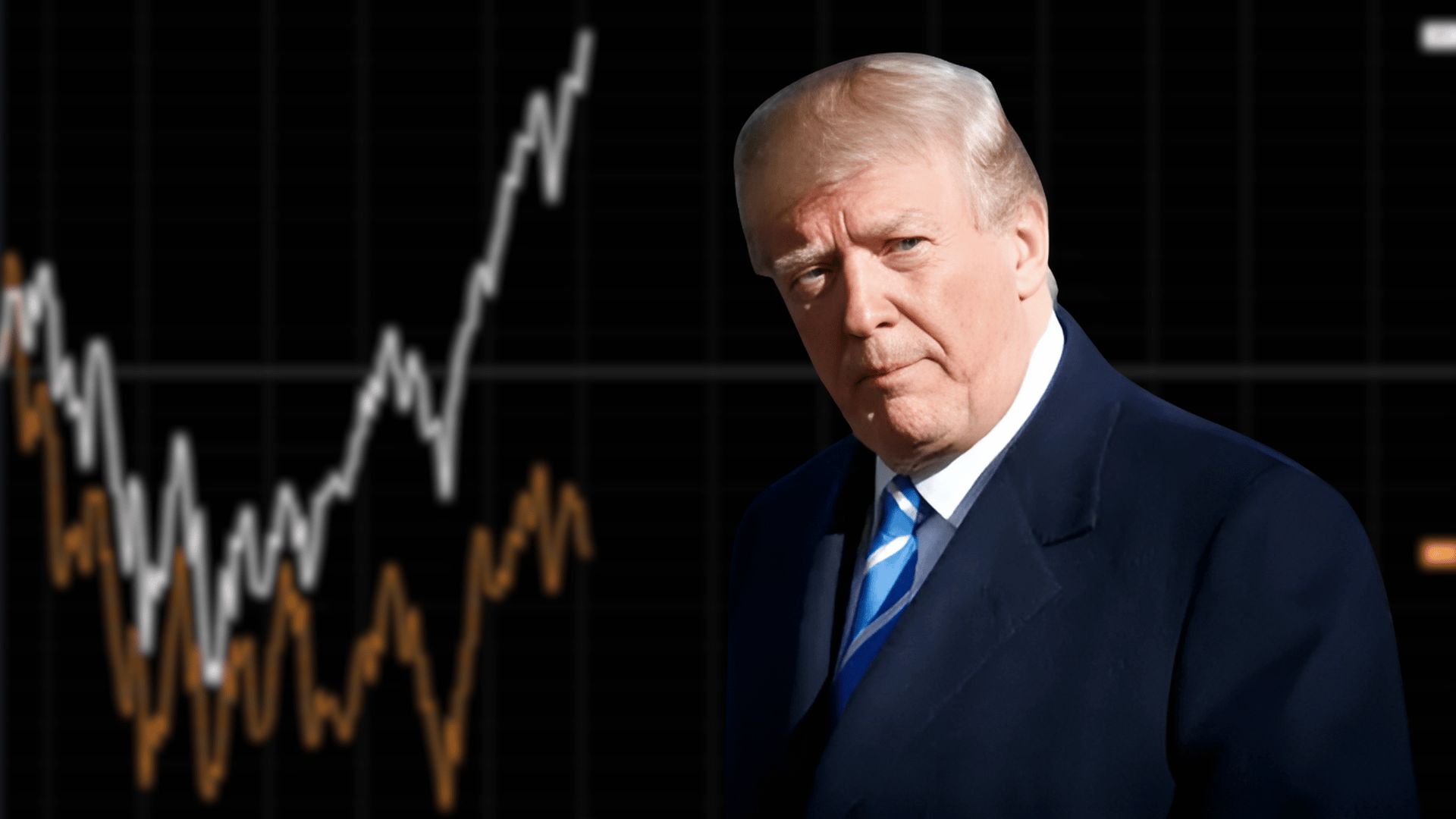The crypto market took a dramatic tumble after President Donald Trump’s Liberation Day speech on Wednesday. Markets panicked after President Trump imposed sweeping tariffs on global trading partners. As a result, Bitcoin (BTC) plunged from an intraday high of $88,554 on Wednesday, dropping to a low of $82,321, a decline of over 3%.
The flagship cryptocurrency is attempting a recovery during the current session but remains marginally down over the past 24 hours. Ethereum (ETH) also registered a substantial decline on Wednesday, falling to a low of $1,785 before rebounding to reclaim $1,800 and settle at $1,824. ETH is still struggling to build momentum and push towards $2,000.
Ripple (XRP) almost fell below $2 as selling pressure intensified on Wednesday. However, it clung on to this level and registered a marginal increase to $2.06. Solana (SOL) registered a substantial decline as it fell below $120 and currently trades at $119. Dogecoin (DOGE) is down almost 2%, while Cardano (ADA) is down over 2%. Toncoin (TON), Chainlink (LINK), Stellar (XLM), Hedera (HBAR), Polkadot (DOT), and Litecoin (LTC) also registered substantial declines.
Crypto Market Meltdown
The crypto market saw a substantial decline as major cryptocurrencies, including BTC, ETH, and SOL, plunged into the red after President Donald Trump announced sweeping tariffs. BTC fell to a low of $82,321 as sellers overwhelmed the support at $83,000. While the flagship cryptocurrency has recovered during the current session, trading volumes remain low. BTC had been trading above $88,000 in the leadup to Trump’s Liberation Day speech. Donald Trump formally announced reciprocal tariffs against several countries, including long-time allies and trading partners. While stocks and crypto had risen in the leadup to the speech, many were hit hard during after-hours trading. China faces a 34% rate and the European Union faces a 20% levy, while Japan will see a 24% rate. John Wu, President at Ava Labs, stated,
“As a risk-on asset, cryptocurrencies have generally traded poorly during periods of uncertainty following announcements such as steady high rates or the introduction of trade tariffs.”
The CEO of crypto research platform DYOR, Ben Kurland, believes markets will dip in the short term, stating,
“Markets will likely dip in the short term, not because of the tariffs themselves, but because of what they represent: the return of policy-driven volatility. Traders hate unpredictability, and this signals more is coming.”
Crypto Market Could Bottom Before June
According to Aurelie Barthere, principal research analyst at Nansen, the crypto market could hit its lowest point in the next two months, with a 70% chance it will happen before June. The timing of the bottom depends on the outcome of ongoing global tariff negotiations, particularly the reciprocal import tariffs announced by US President Donald Trump. The tariffs, intended to reduce the US trade deficit and boost manufacturing, have created uncertainty across financial markets. Trump unveiled the latest salvo of tariffs on April 2, intending to address a $1.2 trillion trade deficit. Markets have already shown volatility in response to previous announcements and have registered a substantial decline following the announcement of the latest tariffs.
BTC and ETH are trading 15% and 22% below their all-time highs, as markets remain stagnant and overly cautious. BTC has been consolidating between $82,000 and $88,000 and has shown limited movement after a period of recalibration during the first quarter. A break above BTC’s consolidation range could signal positive momentum and push the flagship cryptocurrency past $90,000.
Crypto Fear And Greed Index Drops To Extreme Fear
The Crypto Fear and Greed Index fell to 25, dropping 19 points from the previous day, pushing it into “Extreme Fear” territory. The drop comes after President Donald Trump announced aggressive reciprocal tariffs that are unsettling the traditional and crypto markets. Trump set a 10% baseline tariff on imports, with significantly higher rates for specific countries. China was subjected to a 54% tariff, combining a new 34% rate with an existing 20% duty. A 20% rate was also imposed on the European Union, while Vietnam (46%), Taiwan (32%), India (26%), and Japan (24%) were also impacted by the new tariffs. However, Trump exempted Canada and Mexico from the 10% baseline tariff and additional reciprocal levies.
According to reports, the 10% tariff would only be imposed if Trump withdraws the 25% duties currently in place on the two countries. Trump has also imposed a 25% tariff on all cars made in other countries, which will come into effect at midnight on April 4. While investors are skeptical, Trump has promised the tariffs would protect American industries and lead to lower prices.
Bitcoin (BTC) Price Analysis
Bitcoin (BTC) surged past $85,000 in the runup to President Donald Trump’s Liberation Day speech as markets braced for the impact of Trump’s tariff announcements. The flagship cryptocurrency raced to an intraday high of $88,554 as momentum picked up. However, BTC registered a substantial decline following the address as the full extent of Trump’s tariffs was realized. Analysts had warned of a potential decline to $76,000 in the event of negative reactions to tariffs.
“In crypto, sentiment remains broadly subdued. BTC continues to trade without conviction, while ETH holds the line at $1,800 in support. Across the board, crypto markets are showing signs of exhaustion, with numerous coins down 90% YTD, with some shedding over 30% in the past week. Without a material shift in macro or a compelling catalyst, we don't expect a meaningful reversal. While light positioning could support a grind higher, we're not chasing any upside moves until the broader macro picture improves.”
BTC’s post-speech decline can be attributed to tariffs adversely impacting risk appetite, triggering a slump in risky assets. The flagship cryptocurrency plunged over 4%, dropping to a low of $82,321 before recovering during the ongoing session.
BTC’s price action has largely revolved around Trump’s tariff announcement. The asset started the previous week on a positive note, rising almost 2% on Monday, racing to an intraday high of $88,839 before settling at $87,523. BTC encountered selling pressure and volatility on Tuesday and registered a marginal decline. Sellers retained control on Wednesday as BTC registered another marginal drop to slip below $87,000 and settle at $86,942. The price recovered on Thursday to reclaim $87,000 and settle at $87,236. Bearish sentiment intensified on Friday as BTC plunged over 3%, slipping below the 200-day SMA and $85,000 and settling at $84,422.
Source: TradingView
Price action remained bearish over the weekend as the price dropped over 2%, slipping below the 20-day SMA and settling at $82,704. Sellers retained control on Sunday as BTC registered a marginal decline to end the weekend at $82,404. BRC encountered volatility on Monday as buyers and sellers struggled to establish control. Buyers ultimately gained the upper hand as BTC registered a marginal increase and settled at $82,511. Bullish sentiment intensified on Tuesday as BTC rose over 3% to move past the 20-day SMA and settle at $85,150. The flagship cryptocurrency rallied to an intraday high of $88,554 in the leadup to Trump’s Liberation Day speech. However, markets turned bearish, and BTC dropped over 3%, slipping below the 20-day SMA and settling at $82,535. The current session sees BTC up over 1% and trading at $83,680 as buyers look to build momentum and push back above $85,000. However, if sellers regain control, the flagship cryptocurrency could plunge to $80,000 or lower. The MACD suggests buyers have the upper hand, indicating BTC could see an uptrend.
Ethereum (ETH) Price Analysis
Ethereum (ETH) registered a substantial decline following Trump’s Liberation Day speech and the announcement of sweeping tariffs on allies and trading partners. The world’s second-largest cryptocurrency is down almost 3% over the past 24 hours and 10% over the week as selling pressure intensifies thanks to a risk-averse market sentiment. However, it's not all doom and gloom for Ethereum as it reclaimed the top spot in decentralized exchange trading volume for the first time since September 2024. Ethereum-based decentralized exchanges handled $64 billion in spot trading volume compared to $52 billion by their Solana-based counterparts. Meanwhile, BSC-based decentralized exchanges handled $44 billion, according to data from DeFiLlama. However, Ethereum’s fee generation has registered a sharp decline. It earned $142 million in transaction fees in January, a figure that fell to $21 million in March.
According to data from Ultrasound Money, just 53 ETH was burned per day last week. Additionally, ETH’s total supply has grown over 3% since EIP-1559, raising concerns about ETH’s long-term potential. ETH struggled during Q1, ending down 45%. The price registered a substantial increase last week, rising almost 4% on Monday to move past the 20-day SMA and $2,000 to settle at $2,082. However, it lost momentum after reaching this level and registered a marginal decline on Tuesday, falling to $2,068. Selling pressure intensified on Wednesday as ETH dropped almost 3% and settled at $2,010. Sellers retained control on Thursday as ETH dipped to $2,003 after a marginal decline.
Source: TradingView
Selling pressure intensified on Friday as ETH plunged over 5%, slipping below the 20-day SMA and $2,000 and settling at $1,897. Price action remained bearish over the weekend as ETH registered a drop of almost 4% on Saturday and 1.14% on Sunday to settle at $1,807. Despite the bearish weekend, ETH started the current week positively, rising nearly 1% on Monday. Bullish sentiment intensified on Tuesday as ETH registered an increase of 4.57% and settled at $1,905. The price surged to an intraday high of $1,953 on Wednesday. However, it lost momentum after reaching this level and dropped almost 6% to settle at $1,794. The current session sees ETH up over 1% and trading at $1,817 after reclaiming $1,800.
Solana (SOL) Price Analysis
Solana (SOL) has been trading downwards since failing to move past $150 last week. The decline comes despite a strong start to the previous week, starting with an increase of over 6% on Monday, taking the price past $140 to $141. SOL continued to push higher on Tuesday, rising almost 2% and settling at $143 after reaching an intraday high of $147. SOL lost momentum on Wednesday, allowing sellers to take control. As a result, the price dropped over 4% to $137 before registering a marginal recovery on Thursday to settle at $138. Bearish sentiment intensified on Friday as SOL fell over 6%, slipping below the 20-day SMA and $130 to settle at $129. Sellers retained control on Saturday, pushing SOL down by almost 4% to $124.
Source: TradingView
SOL registered a marginal increase on Sunday despite the overwhelming selling pressure to end the weekend on a positive note. However, SOL was back in the red on Monday, registering a marginal decline. Buyers returned to the market on Tuesday as the price registered an increase of almost 2% and settled at $126. SOL surged to an intraday high of $136 on Wednesday as markets rallied in the runup to Trump’s Liberation Day speech. However, sentiment changed following the speech. As a result, SOL plunged over 7%, slipping below $120 and a key support level to settle at $117. SOL has recovered during the ongoing session, with the price up over 1% and trading at $118. Buyers will look to retain control and push SOL back above $120. Failure to break above this level could allow sellers to drive the price to $100.
Celestia (TIA) Price Analysis
Celestia (TIA) has declined substantially since the weekend as it plunged below key moving averages and support levels. TIA started the previous week with an increase of almost 3%, moving to $3.64. Buyers retained control on Tuesday as the price rose over 1% to $3.69. However, TIA lost momentum after reaching this level and dropped almost 3% on Wednesday, falling to an intraday low of $3.47 before settling at $3.59. The price rebounded on Thursday, rising over 3% and settling at $3.70. Bearish sentiment returned on Friday as TIA fell 7.53%, slipping below $3.50 and the 20-day SMA and settling at $3.42.
Source: TradingView
Price action remained bearish on Saturday as TIA fell over 6%, slipping below the 50-day SMA and settling at $3.21. TIA recovered on Sunday, surging to an intraday high of $3.37 before settling at $3.24, ultimately registering an increase of almost 1%. However, the price was back in the red on Monday, dropping over 5% and settling at $3.07. TIA recovered on Tuesday despite the overwhelming bearish sentiment, registering an increase of over 2% and settling at $3.14. Markets turned bearish on Wednesday following President Trump’s Liberation Day speech. As a result, TIA plunged over 7%, slipping below $3 and settling at $2.92. The current session sees TIA down over 2% and trading at $2.85. If sellers retain control, TIA could drop to $2.70, where it could find support.
Arbitrum (ARB) Price Analysis
Arbitrum (ARB) registered a marginal increase on Tuesday before a sharp decline on Wednesday, falling almost 3% and settling at $0.381. The price recovered on Thursday, registering a marginal increase and settling at $0.384. However, price action turned bearish on Friday as ARB plunged over 9%, slipping below the 20-day SMA and settling at $0.347. Sellers retained control on Saturday, as the price dropped 4.86% and settled at $0.330. Despite the overwhelming selling pressure, ARB registered a marginal increase on Sunday to end the weekend at $0.331.
Source: TradingView
ARB started the current week on a bearish note, dropping over 1% and settling at $0.327. The price recovered on Tuesday, rising almost 2% and settling at $0.333. Markets turned bearish on Wednesday, and ARB fell 8%, slipping below a key support level and settling at $0.306. The current session sees ARB marginally up as buyers and sellers look to establish control. The MACD is bearish, indicating sellers have the upper hand, and ARB could see a decline in the coming sessions.
Dogwifhat (WIF) Price Analysis
Dogwifhat (WIF) has traded in the red since Monday last week, as bearish sentiment drove the popular meme coin below key levels. WIF started the previous week on a positive note, rising over 2% and settling at $0.558. However, it lost momentum on Tuesday, dropping 1.53% to $0.549. WIF attempted a recovery on Wednesday, surging to an intraday high of $0.59. However, it lost momentum after reaching this level and dropped almost 4% to settle at $0.528. Sellers retained control on Thursday as WIF dropped nearly 2% and settled at $0.519. Selling pressure intensified on Friday as WIF plunged over 11%, slipping below the 20-day SMA and $0.50 to settle at $0.46.
Source: TradingView
Price action remained bearish on Saturday as WIF dropped over 6% and settled at $0.432. WIF registered a marginal recovery on Sunday, rising just over 1% to end the weekend on a positive note at $0.436. The price was back in the red on Monday, dropping almost 4% to $0.419. Buyers attempted a recovery on Tuesday as the price rose to an intraday high of $0.445. However, it could not stay at this level and ultimately settled at $0.422 after a marginal increase. Price action turned bearish on Wednesday as WIF plunged over 11%, slipping below $0.40 and settling at $0.373. The current session sees WIF marginally up as buyers and sellers struggle to establish control. Buyers will look to build momentum and push the price back above $0.40.
Polkadot (DOT) Price Analysis
Polkadot (DOT) has seen a stunning decline since December, when it surged to $11.66 following Donald Trump’s election victory. However, DOT is back below $5, having dropped over 50% over the past year. DOT got off to a strong start last week, rising almost 3%, reaching an intraday high of $4.77 before settling at $4.63. Buyers retained control on Tuesday as DOT registered a marginal increase before rising 1.51% on Wednesday, moving past the 50-day SMA and settling at $4.70. However, DOGE lost momentum after reaching this level and dropped 1.70% on Thursday to settle at $4.62. Bearish sentiment intensified on Friday as DOT plunged over 7%, slipping below the 50 and 20-day SMAs and settling at $4.28. Price action remained bearish on Saturday as DOT dropped over 5% and settled at $4.05.
Source: TradingView
Sunday saw DOT register a marginal decline as buyers prevented a drop below $4, with the price remaining static at $4.05. However, DOT started the current week with a marginal drop and settled at $4.02. DOT recovered on Tuesday as it registered an increase of 3.98%, racing to an intraday high of $4.28 before settling at $4.18. Bearish sentiment intensified on Wednesday as DOT plunged over 5%, slipping below $4 and settling at $3.96. The current session sees DOT marginally up as it looks to reclaim $4 and push toward $4.50.
Disclaimer: This article is provided for informational purposes only. It is not offered or intended to be used as legal, tax, investment, financial, or other advice.

 19 hours ago
14
19 hours ago
14









 English (US) ·
English (US) ·